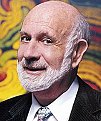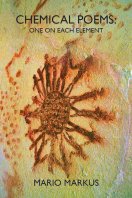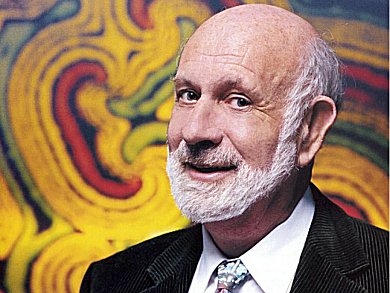Professor Mario Markus, Dortmund, Germany, has spent his life exploring “the corners of the universe”, first as a physicist looking at instabilities in plasmas and self-organizing physico-chemical patterns, then as an artist, author, and poet exploring human nature as well as the artistry of science.
He talks to Dr. Vera Köster for ChemistryViews about his latest series of poems, each one describing an element of the periodic table, what art can offer science, and why he never learned to dance to Rock and Roll.
Tell us a bit how your career started, please.
Well, I guess my career started in high school in Chile, where I grew up. I had transformed my parents’ house into an astronomical observatory and a research lab on ant behavior. The price was that I never learned to dance to Rock and Roll. Later, during my doctorate work in Heidelberg, Germany, I fell in love with self-organization, a subject that accompanied me then to Dortmund, where I became a professor and a research group leader at the Max Planck Institute for Molecular Physiology.
What made you interested in sciences?
This also started in high school. In a time when no television existed yet in Chile, the lessons in chemistry and physics were like telenovelas for me. I was thrilled by wondering, what the teachers would be telling us next.
Later on, I chose to study physics because of a philosophical conviction: At that time, physics was for me the only subject that can honestly lead us to the most remote corners of the universe. In contrast, religion relies on faith, literature on the fantasy of the authors, chemistry – at that time for me – on mesoscopic empirism …
What was your scientific work focused on?
I worked mainly with self-organizing physico-chemical patterns. Among other things, I discovered turbulence in the inorganic Belousov-Zhabotinsky reaction. And a chaotically pulsing biochemical clock.
What inspired you to write poems?
After I had more or less completed my scientific career, I realized that there was one domain about which physics didn’t give me answers, namely human nature. So I prepared myself for a journey within my old search for all “corners of the universe”. This included “painting” with the computer and writing a novel and poems.
And there was something else. The Birkhäuser-Verlag in Basel, Switzerland, edited a book called “Verknüpfungen”, meaning “Connections”, in which my computer “paintings” were put together with subjectively matching poems by Hans-Magnus Enzensgerger, Günter Kunert, Josef Reding, and others. During the editing process I got inspired by these poets.
So you carried on other artistic activities before you wrote the poems on the chemical elements?
Yes. First of all, while doing graphs on the stability of physical and chemical systems, I realized that if I “cheated” by inventing the underlying equations, I could produce astonishing graphs. I published this in the book “Die Kunst der Mathematik” and displayed it in a lot of exhibitions all over the world.
Then I wrote a science-fiction novel in Spanish, “Bilis Negra”, which wasn’t much of a success. However, a comic was made out of it, which sells excellently.
Parallel to all that, verses on everyday experiences emerged and I compiled the poems in the book “Punzadas” (“Twinges”), also in Spanish. Then I started to translate Latin American poems into German, recited them in many countries and produced bilingual CD-books. The chemical poems are just a small part of these activities.
Where do you get your ideas from?
I didn’t look for the particular ideas; they just appeared suddenly after waking up in the morning or while sitting on a train.
For whom are you writing the poems on the elements?
First of all, for all those people who think chemistry is cold and far from humanities, who say “ugh” to it. I was already disgusted in school about people like that. Secondly, I’m writing them for the literati, who reuse over and over the metaphors related to love, death, landscapes, and religion. Science renders an enormous amount of new metaphors for literati to enjoy.
The only problem, of course, is that the non-scientific reader may not understand them, so I had to give explanations along with the poems on the elements.
I would call your poems scientific lyrics, but how would you classify the literary style of your poems?
In general, these poems may be classified into the field of Imagism, a movement that appeared at the beginning of the 20th century. One of its major representatives is the English poet Richard Aldington. Imagism is characterized by a clear, sharp, and simple language with a direct treatment of the “thing” and using absolutely no word that does not contribute to the presentation.
As regarding rhythm, the poems are composed in sequence of the internal musical phrase and are not bound to formal metrics.
Generally it is assumed that scientists cannot bring about works of literature and art, and vice versa, as normally the range of competence of each is distributed asymmetrically. What do you think about this? Can art benefit sciences and vice versa?
For me the asymmetric distribution of the ranges of competence is a handicap. I am convinced that the great works of science derive from a non-technical intuition and fantastic, poetical assumptions: from the concept of a gravitational field through relativity to quantum mechanics, particle physics, and cosmology. Bean counters who just rearrange that what is known are doomed to remain bean counters. Art could help them.
The same applies to poets who close their eyes to the marvels of science. Moreover, the “two cultures”, art and science, if not exactly distributed in the two halves of the brain as many people believe, are distributed in different parts of our brains and anyone who neglects the value of one of the cultures is thus castrating (physically castrating!) oneself.
Your poems were published in German and Spanish as a book and you have given many readings in German, English and Spanish around the world. What kind of feedback did/do you get on your poems?
People who just look at the books are not always enthusiastic. However, when I give a reading and I (or the person who introduces me) say/s things like those I have said in this interview, interest blossoms. Thus, I believe that for this kind of thing it is an important task to inspire people, to become a missionary for the conciliation of the two cultures.
Do you have any other interesting projects coming up?
Oh yes! As a teenager I was a passionate butterfly collector. Now I feel very sad when I visit my old “hunting grounds” and see nothing. As a result of that I have been writing during the last years a book about the extinction of insects as well as about their amazing capacities and benefits for all of us. This book will be published in the Kosmos-Verlag, Stuttgart, at my 70th birthday in 2014. It contains many photographs of insects that have disappeared.
Another book, which I plan to write after that, will be on quasi-two-dimensional crystals, like the ice flowers that form on windows. Their shape changes by changing the chemical composition. For this I have installed a lab in my private house near the campus. The lab is a gift from the Max Planck Institute after working there for 35 years. The aim of this book is to give instructions on producing such crystals as a hobby in people’s homes.
Thank you for the interview.

Mario Markus studied mathematics, biology, chemistry, and physics at the Universidad de Chile, graduating in 1965. From 1965–1973, he studied physics at the University of Heidelberg, Germany, and gained his Ph.D. from there on the subject of instabilities in plasmas. He spent a year as a research assistant at the Institute for Theoretical Physics of the University of Heidelberg, Germany, before taking up a research scholarship at the Max Planck Institute for Biophysics, Frankfurt, Germany. In 1975, Markus joined the Max Planck Institute for Nutrition Physiology, Dortmund, Germany, as a research fellow. He gained his Habilitation and later his Professorship at the Physics Department of the University of Dortmund. In 1993 he became Head of Working Group at the Max Planck Institute for Molecular Physiology, Dortmund. Markus retired from this position in 2010, but remains a Visiting Scholar at that Max Planck Institute.
 Chemical Poems – One On Each Element,
Chemical Poems – One On Each Element,
Mario Markus,
Dos Madres Press 2013.
ISBN: 978-1-933675-98-5
Perfectbound, 308 pages, English, $30
Selected Publications
- Transitions between oscillatory modes in a glycolytic model system,
M. Markus and B. Hess,
Proc. Natl. Acad. Sci. USA 1984, 81, 4394–4398.
DOI: 10.1073/pnas.81.14.4394 - Isotropic cellular automaton for modelling excitable media,
M. Markus and B. Hess,
Nature 1990, 347, 56–58 and cover.
DOI: 10.1038/347056a0 - Phototaxis of spiral waves,
M. Markus, Zs. Nagy-Ungvarai and B. Hess,
Science 1992, 257, 225–227.
DOI: 10.1126/science.257.5067.225 - Disordered waves in an homogeneous, motionless excitable medium,
M. Markus, G. Kloss and I. Kusch,
Nature 1994, 371, 402–404.
DOI: 10.1038/371402a0 - Lyapunow-Diagramme,
M. Markus,
Spektrum der Wissenschaft 1995, April, 66–73.
Link - Mollusc Shell Pigmentation: Cellular Automaton Simulations and Evidence for Undecidability,
Ingo Kusch, Mario Markus,
J. Theor. Bio. 1996, 178(3), 333–340.
DOI: 10.1006/jtbi.1996.0029 - Splitting of autowaves in an active medium,
A. P.-Munuzuri, V. Perez-Villar, and M. Markus,
Phys. Rev. Lett. 1997, 79, 1941–1944.
DOI: 10.1103/PhysRevLett.79.1941 - Riddled-like basins of transient chaos,
M. Woltering and M. Markus,
Phys. Rev. Lett. 2000, 84(4), 630–633.
DOI: 10.1103/PhysRevLett.84.630 - Cicadas showing up after a prime number of years,
M. Markus and E. Goles,
Mathematical Intelligencer 2002, 24, 30–33.
DOI: 10.1007/BF03024615 - Double-diffusive convection: a simple demonstration,
M. Markus,
J. Chem. Ed. 2004, 81, 526–529.
DOI. 10.1021/ed081p526 - Charts for prediction and chance,
M. Markus,
Imperial College Press, London, UK, 2007.
ISBN: 978-1860948350 - Die Kunst der Mathematik,
M. Markus,
Verlag Zweitausendeins, Germany, 2009.
ISBN: 978-3861507673 - Poemas Químicos,
M. Markus,
LOM Ediciones, Santiago, Chile, 2010.
ISBN: 978-9560001900
Selected Awards
- Best exhibition of the year 1988 (“Estética en las Ciencias”), issued by the Chilean Association of Art Critics
- Award of the Chilean Ministry of Foreign Affairs for the bilingual (Spanish-German) audio book “Poesía Chilena” (Sello Alerce, Chile, 2005)
Also of Interest

A compilation of articles on chemistry in artworks, on art inspired by chemistry, about the work of scientific teams in museums




